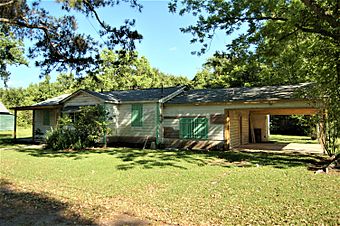Robert "Bob" Hicks House facts for kids
Quick facts for kids |
|
|
Robert "Bob" Hicks House
|
|
 |
|
| Location | 924 E. Robert "Bob" Hicks (formerly 9th) St., Bogalusa, Louisiana |
|---|---|
| NRHP reference No. | 14001174 |
| Added to NRHP | January 20, 2015 |
The Robert Hicks House in Bogalusa, Louisiana, was a very important place during the Civil Rights Movement. From 1965 to 1969, it was the home of Bob Hicks (1929–2010), a brave leader who fought for equal rights. This house was also a secret meeting spot for civil rights groups in the city.
The house itself was built in the early 1950s. It's a one-story building, about 1,590 square feet in size. It looks a bit like houses built in the 1950s and 1930s. It has wooden siding and stands on concrete supports. On the property, there's also an older "mill house" from 1906. This was built by the Great Southern Lumber Company when they created the town of Bogalusa.
Contents
History of the Robert Hicks House
Bob Hicks and the Fight for Rights
Bob Hicks was a key leader in the Civil Rights Movement in Bogalusa. He helped start a local group called the Deacons for Defense and Justice in February 1965. This group was formed to protect civil rights activists and their families. At that time, people fighting for equal rights were often threatened by groups like the Ku Klux Klan. The Deacons organized men to stand guard and keep everyone safe.
Hicks was also a leader of the Bogalusa Civic and Voters League (BCVL). This group worked to help Black citizens register to vote. Voting was a very important way to make changes and gain equal rights.
A Historic Meeting Place
The Robert Hicks House was a central hub for these important groups. It served as the main office for the BCVL's leaders. It was also the meeting place for the Deacons for Defense and Justice. Because of its vital role, the house was added to the National Register of Historic Places in 2015. This means it's recognized as a special place in American history.
Standing Up to Threats
On February 1, 1965, the Hicks family faced a serious threat. White groups tried to scare the BCVL activists by threatening to bomb the house. But Bob Hicks and his family stood strong. Just a few weeks later, on February 21, 1965, Hicks and others officially started the local chapter of the Deacons for Defense and Justice. Their goal was to protect activists and their families from harm.
Fighting for Public Spaces
In May 1965, Bob Hicks took part in another important event. He joined other Black citizens who tried to use one of Bogalusa's public parks. Even though the national Civil Rights Act of 1964 had passed, which said public places could not be segregated, some local white people still tried to keep Black people out of parks and other areas.
These disagreements continued through the summer of 1965. In July, the United States government stepped in. They used an old law to order the local police to protect the civil rights activists. This was a big step towards making sure everyone had equal access to public places.
Today, a special plaque stands at the house to remember its history. The Robert Hicks Foundation is now working to create a civil rights museum at the site. This museum will help future generations learn about the brave people who fought for justice.
Remembering Bob Hicks
A historic marker at the house tells more about Bob Hicks' amazing life. It explains that he was driven by the unfair rules and threats that affected his community and family. He had a strong desire for fairness and equality. He inspired many people and communities to join the fight.
Bob Hicks helped plan rallies, marches, and daily protests. He also helped organize boycotts, where people refused to buy certain goods or services to make a point. He arranged for protection for those who were targeted because of their race or beliefs. He also started successful legal challenges that helped end segregation. This meant stopping "separate but unequal" practices in schools, jobs, laws, government, voting, healthcare, and housing.
Bob Hicks was a member of the NAACP, a leader in the Prince Hall Masons, and president of the Bogalusa chapter of the Deacons for Defense and Justice. He was also the first African American supervisor in the paper mill's box plant. He was an ordinary man who did extraordinary things to fight for justice for all Americans.
The marker also describes the events of February 1, 1965. When the Ku Klux Klan planned to bomb his home, the police told Robert Hicks they could not protect his family. The Klan was angry that Hicks was letting two white civil rights workers stay at his house and demanded they leave. Hicks bravely said no. He and his wife sent their five children to a safe place and asked friends for help. Armed Black men stood guard all night.
On February 21, the Deacons for Defense and Justice from Jonesboro, Louisiana, visited Bogalusa. They helped start a local chapter, focusing on self-defense. Bob Hicks took the lead in forming this Bogalusa chapter. The Deacons' actions helped change history and started a strong Civil Rights Movement in the area. Their work also pushed the U.S. Government to enforce the 1964 Civil Rights Act, which helped control the Klan's actions.
The Hicks' home was the starting point and meeting place for the Deacons, activists, lawyers, and human rights supporters. It was a safe place for everyone. The decisions made in this home had a big impact on the future of the community, Louisiana, and the entire nation. Bob Hicks showed incredible courage in his fight for justice and equality.
See also
- Deacons for Defense (film)
- National Register of Historic Places listings in Washington Parish, Louisiana



